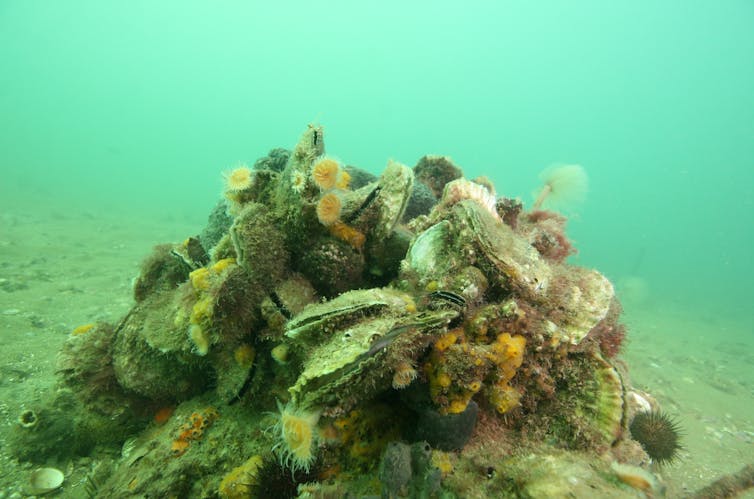Efforts to restore marine reef ecosystems are being promoted worldwide; however, many of these efforts end up failing because they were not implemented at the required scale.
To achieve effective scales, scientific knowledge in restoration methods must be combined with industry-based approaches used for infrastructure development.
Researchers from Delft University of Technology, Royal Netherlands Institute for Sea Research (NIOZ), Utrecht University, and HZ University of Applied Sciences published a study describing five principles on how marine contractors in large-scale projects can support reef restoration.
According to the researchers, the principles are:
- Use industrial techniques to achieve a positive impact at scale.
- Landscape infrastructure to optimize the habitat of target species.
- Overcome connectivity bottlenecks and guide community composition.
- Design nature development efforts to be self-sustaining.
- Ensure continuity beyond project boundaries through early stakeholder involvement.

Principle I: Use industry-based techniques
- 1 Principle I: Use industry-based techniques
- 2 Principle II: Optimize marine infrastructure as habitat
- 3 Principle III: Initiate and guide community composition
- 4 Principle IV: Support self-sufficiency
- 5 Principle V: Ensure continuity through stakeholder engagement
- 6 Conclusion
- 7 Entradas relacionadas:
The study states that current restoration practices are often too small in scope to address the extensive anthropogenic threats causing habitat loss.
Researchers highlight the urgent need to shift towards cost-effective solutions that can be implemented at kilometer-scale or larger. These innovative solutions can be borrowed from industries that have already discovered economies of scale.
For instance, small and isolated restoration sites will have lower genetic diversity, resulting in reduced resilience. Connectivity with remaining ecosystems through proximity allows for species and gene exchange, leading to increased biodiversity and resilience in restored areas.
Stay Always Informed
Join our communities to instantly receive the most important news, reports, and analysis from the aquaculture industry.
To achieve ecologically successful and cost-effective restoration practices, interventions must be executed on a sufficiently large scale.
Principle II: Optimize marine infrastructure as habitat
Reef ecosystem restoration often involves installing artificial structures to provide a hard substrate in various three-dimensional forms that promote biodiversity.
These structures are custom-made for a local system and target specific groups of species, such as corals or fish.
Concrete is often used as the main construction material. Disadvantages of using concrete include toxicity due to cement mortar leaching trace metals over time and carbon dioxide emissions during manufacturing.
In addition to restoring habitat through the deliberate addition of artificial reef structures, optimizing new or existing marine infrastructure should also be considered to achieve desired impacts. This landscaping approach could fulfill similar restoration objectives, potentially at a much larger scale, using either the same additional materials or marginal materials alone.
Marine construction works, such as coastal breakwaters, quay walls in ports, and scour protection in offshore wind farms, already inherently provide artificial habitat.
Principle III: Initiate and guide community composition
Any newly constructed marine structure provides a hard substrate habitat that is prone to colonization by marine organisms.
According to the researchers, the benthic community development on a new structure can be steered in the desired direction, not only by optimizing habitat conditions but also by proactively incorporating target species.
Principle IV: Support self-sufficiency
If interventions are needed to kickstart recovery, the ideal scenario is to achieve a self-regulating and self-sustaining ecosystem without the need for future human intervention to further guide restoration outcomes. This goal of “rewilding” a system has both economic and ecological benefits.
Once the target system becomes self-sufficient, costly interventions are no longer required. Self-sufficiency also indicates good health, with the ecosystem capable of maintaining its structure and function over time in the face of external stressors.
Principle V: Ensure continuity through stakeholder engagement
The timelines for ecological restoration rarely align with those of marine construction and active restoration projects. However, achieving long-term restoration goals may require more time than initially anticipated for initiated measures, and ongoing activities may be necessary.
Furthermore, restoration efforts should be monitored over a period of 15 to 20 years to allow for a robust assessment of whether ecosystem recovery and associated functions and services have been achieved.
In this regard, the continuation of restoration activities and their evaluation requires the participation of local partners who are willing to take responsibility beyond the initial phase.
The researchers emphasize that early involvement is important to ensure that partners take ownership of the activities and to ensure sufficient resources for ongoing monitoring and maintenance once the work is initiated.
Conclusion
The rapid decline of coral reef ecosystems calls for a shift in current restoration practices and the development of new approaches.
“The five golden principles presented in this study demonstrate how to incorporate industry partners’ expertise to promote effective restoration of marine reefs,” conclude the researchers.
Reference (open access):
ter Hofstede, R., Bouma, T. J., & van Koningsveld, M. 2023. Five golden principles to advance marine reef restoration by linking science and industry. Frontiers in Marine Science, 10, 860.
Editor at the digital magazine AquaHoy. He holds a degree in Aquaculture Biology from the National University of Santa (UNS) and a Master’s degree in Science and Innovation Management from the Polytechnic University of Valencia, with postgraduate diplomas in Business Innovation and Innovation Management. He possesses extensive experience in the aquaculture and fisheries sector, having led the Fisheries Innovation Unit of the National Program for Innovation in Fisheries and Aquaculture (PNIPA). He has served as a senior consultant in technology watch, an innovation project formulator and advisor, and a lecturer at UNS. He is a member of the Peruvian College of Biologists and was recognized by the World Aquaculture Society (WAS) in 2016 for his contribution to aquaculture.




